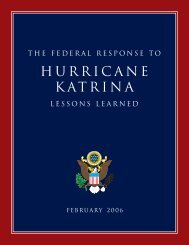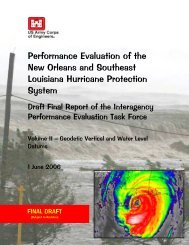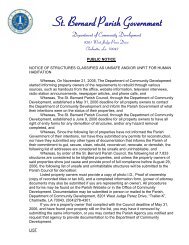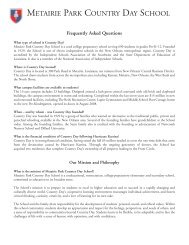IPET Report 3 Vol VIII
IPET Report 3 Vol VIII
IPET Report 3 Vol VIII
You also want an ePaper? Increase the reach of your titles
YUMPU automatically turns print PDFs into web optimized ePapers that Google loves.
Assessment of Hurricane Loads<br />
Finding the environmental loads for each parameter set of interest is the most challenging<br />
task of hurricane hazard characterization. The following paragraphs describe how this is done for<br />
still water levels, waves, and rainfall intensity.<br />
Still Water Levels and Waves. It is well known that surge and waves interact (surge affects<br />
waves and vice-versa). Therefore, these loads should be ideally assessed using a coupled formulation.<br />
Sophisticated coupled programs are currently being developed that reflect this coupling,<br />
but at the present time such programs are not at a stage that they can be routinely used.<br />
An alternative is to follow an iterative approach, whereby the surge H(x,y,t) without waves<br />
are first calculated, the wave field estimated given the preliminary estimate of the surge, and<br />
finally the surge code is re-run considering the calculated wave field. While the treatment of<br />
waves for the risk analysis uses a simple wave parameterization scheme based on results<br />
obtained in previous detailed analyses. This parameterization approach should produce rather<br />
accurate results and greatly streamlines computations (Robert Dean, personal communication).<br />
Surges are calculated using the ADCIRC code (Luettich et al. 1992).<br />
ADCIRC uses a triangular grid with spatially varying resolution, which for the risk analysis<br />
application covers the entire Gulf of Mexico. The resolution increases in coastal areas, in<br />
particular near the Louisiana Coast. High-resolution grids may include millions of nodes and<br />
must be run with time steps on the order of 1 second to avoid numerical problems. Such dense<br />
grids produce accurate results and can adequately resolve topographic effects on horizontal<br />
scales of tens of meters along the coast.<br />
Since it is not feasible to use such dense computational grids for all the parameter combinations<br />
in Table 6, a different strategy was adopted to avoid, running all cases by using computational<br />
grids at lower resolutions.<br />
Reduction in the Number of ADCIRC Runs. Two conditions were taken advantage of<br />
reduce the number of runs: (1) If the dependence of the results on a parameter A is smooth, then<br />
results were calculated for a subset of levels of A and interpolation used for the other levels, and<br />
(2) If two parameters A and B do not interact (additively or multiplicatively), then the (additive<br />
or multiplicative) effect of varying one of them is the same irrespective of the level of the other<br />
parameter. In this case all combinations of A and B was inferred by varying each parameter<br />
while keeping the other parameter constant. Determination of whether either condition applies<br />
was made using a low-resolution (LR) ADCIRC grid run with only a few thousand nodes<br />
ignoring the effect of waves.<br />
These considerations reduce the number of needed ADCIRC runs from about 26,000 in<br />
Table 6 to about 1,000. However, even 1,000 hurricane scenarios are too many to be run with a<br />
high-density grid. The strategy selected is to run these cases with a medium-resolution (MR) grid<br />
with approximately 90,000 nodes and use the high-resolution (HR) grid for only about 40 cases.<br />
The HR runs are then used to calibrate the MR results.<br />
<strong>Vol</strong>ume <strong>VIII</strong> Engineering and Operational Risk and Reliability Analysis <strong>VIII</strong>-33<br />
This is a preliminary report subject to revision; it does not contain final conclusions of the United States Army Corps of Engineers.













